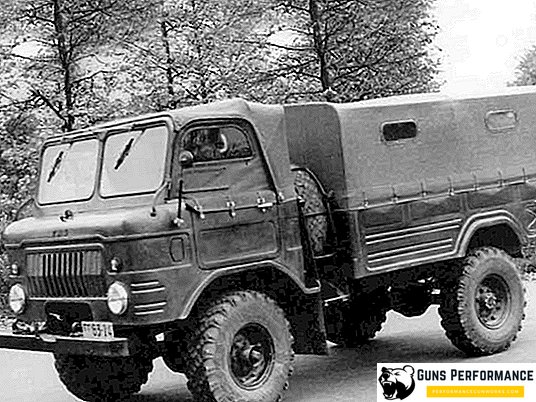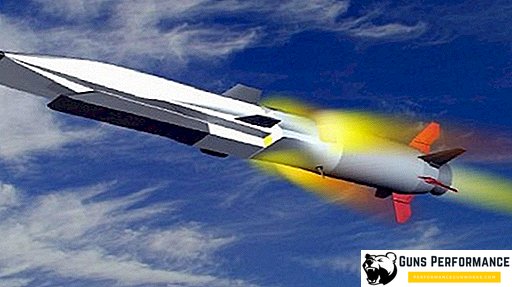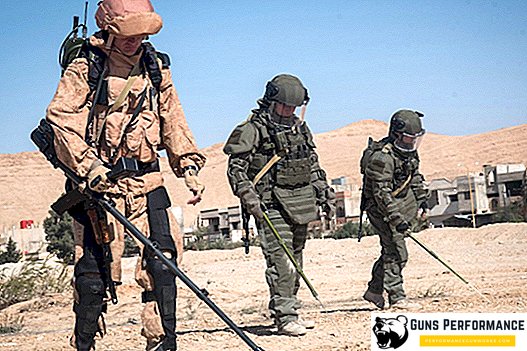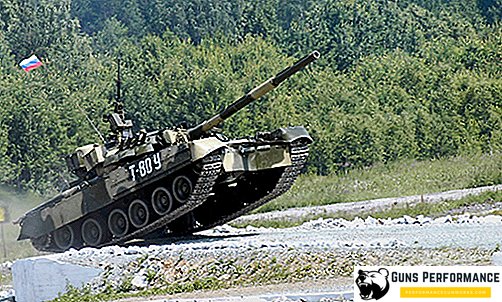GAZ-62 - Soviet truck with wheel formula 4x4, the development of which started before the start of the Second World War. Engineers offered several options, including the bonnet and bonnet layout.

General information about all-terrain vehicle GAZ-62
The 62nd model was positioned as a high-traffic vehicle for the transport of goods and people in difficult road conditions or off-road. The main structural features are considered high ground clearance and cam locking differentials.
On the ground or in wetlands, a truck could move with low tire pressure, which was considered a great achievement for the middle of the last century. The dimensions of the car and removable parts made it possible to transport by helicopter and disembark by parachute. The power unit was located under the cab. To access the technology, the cabin was folded forward with the help of springs.
The power plant GAZ-62 has 6 cylinders and is supplemented with a pre-chamber and flare ignition system. Many developments made for this car were used in the future on other generations of trucks produced by the Gorky Automobile Plant.

The first sample of the truck GAZ-62
Assembled in 1940. The company was preparing for the beginning of the war, experiments with 6x4 transport showed that such developments have low efficiency. Such a wheel formula was popular in the 30s, but by the beginning of the 40s it was morally obsolete. The army demanded a car with all-wheel drive to overcome any (possible on the road) obstacles.
The breakthrough in the production of all-wheel drive trucks occurred after the purchase of American equipment for the manufacture of ball joints of equal angular velocity. GAZ-62 became the first 4x4 Gorky cars. It is based on the powerful GAZ-11 engine with six cylinders and a volume of 3.48 liters. It was developed based on the Dodge D5. At 3.4 thousand revolutions, the power of 76 hp was developed.
The transfer case lever was installed in one of four positions:
- 1 - the rear axle is activated;
- 2 - hard inclusion of both bridges;
- 3 - neutral;
- 4 - activation of both bridges through a demultiplicator with a gear ratio of 1.82: 1.
The main gear had a gear ratio of 6.66: 1. Largely due to this, it turned out a car with high traffic. Tires received a special tread pattern called "Ground Flu".
The basis of the cabin is taken from the serial GAZ-MM. The dimensions of the hood are increased, since the engine of other dimensions was used. The design of the grille developed from scratch. In the process of modernization, the cast iron used to produce the cylinder head was replaced with aluminum. Due to this power increased to 85 horsepower. The first tests were carried out with such a motor. All tests were successful: the car showed the required dynamics and off-road permeability.
The maximum speed with full load (2 thousand kilograms) is 88 km / h. In 1941, the first tests were carried out with a full load on the roads, which also passed satisfactorily. For movement on snow, wheels were equipped with lugs and bracelet chains (worn separately). Transport moved through snow drifts up to 60 centimeters deep.
The minimum fuel consumption with a power unit with cast iron heads was 16.2 liters per 100 kilometers at an average speed of 35-45 km / h. After replacing cast iron with aluminum, consumption decreased to 15.7 liters per 100 kilometers. The average consumption of asphalt coating was 25 liters, on the roads - 60 liters.
Before the war, the designers managed to develop a modification with a wheel formula 6x6. New cars were given the index "33". He also arranged the military leadership of the country in all respects. After the start of the war, the project was postponed in a "long" box. In the future, the developments of the GAZ-62 model of 1940 formed the basis of the 63rd model.

The second sample GAZ-62
Back to the development of "62" was due to the presence of Dodge trucks. Their USSR received from American partners during the war as support. The military liked it for its simplicity of design and the possibility of prompt repair in field conditions. High throughput is achieved due to good weight and large wheels.
The second generation appeared in 1952. Outwardly, it looked like a reduced GAZ-69, on which engineers worked at the same time as the project. Overall characteristics of the second sample:
- Length - 5 meters;
- Width - 2.1 meters;
- Height - 1.8 meters;
- Wheelbase - 2.85 meters.
The maximum speed is 85 km / h. Vehicles could carry loads weighing up to 1.2 thousand kilograms. Body capacity was 11 people.
"Under the hood" worked the same engine. The design was carried out in strict accordance with the requirements of the army. Due to this, several innovative solutions appeared in the design. Impressions springs got rubber pads. Smooth movement ensured the presence of rear springs of variable stiffness. The cabin was located heating equipment.
For serial copies planned to use unique tires 10,00-16 (developed specifically for the 62nd model). Their main feature was a new tread pattern - "oblique dismembered tree". While the development of new wheels was in progress, American tires 9.00–16 with a “forest” tread pattern were used for the first tests.

The first copy was collected on October 3, 1952. October 22, he was sent for testing. For 53-54 years, collected four more cars. They received minor technical changes: brakes, differentials and tires.
Until the end of the winter of 1953, the car passed a route 15 thousand kilometers long. Indicators were compared with Dodge. The results staged the army chiefs. According to the dynamics, the Russian product was inferior due to lower power and greater weight, but it was ahead in terms of carrying capacity, economy and maneuverability.
After that, the GAZ-62 was sent to military trials. At the end of the transport received positive feedback. Experts have identified several shortcomings that needed to be corrected during the subsequent modernization. The final stage was the state testing, the results of which the product received a recommendation review for serial production.
In the process of working on the standard version of the developed cargo, which received the index "A". She received a body with an increased volume, and the spare wheel was placed in a horizontal position. Also, the truck got a mechanical winch.
When finalizing the design supplemented hermetic drum brakes. Mechanisms are not subject to wear due to water and dirt. Due to this, the braking efficiency is improved. All parts of the brake mechanism were mounted inside the brake drum at the splines of the axles of the drive axle. This influenced the appearance: diskless wheels became flat. Only the hubs in the center and the studs with the nuts of the rim mounts protruded.
The design of the brake system, which had many operational advantages, received a number of minuses. She had been going for a long time, had not been repaired in the field, and had a high cost price. During the tests, the main drawback emerged: the dust accumulating inside wore out all the mechanisms, which led to an early breakdown. Engineers had to abandon this construction solution.
Perspective in all plans of the car did not reach the conveyor. The exact reasons for which they did not organize the serial release are unknown.

The third sample GAZ-62
The last generation has become shorter, but higher. The technical characteristics made it possible to transport military personnel up to 12 people or cargoes weighing no more than 1.1 thousand kilograms. The assignment remained the same, so many design solutions have been preserved from the previous prototype.
From the 63rd model took the friction clutch and four-speed manual gearbox. Razdatku made from scratch. It is based on a two-stage gearbox with two gears: higher (straight) and lower.
The transmission was deprived of the center differential, so the drive of the front axle was activated forcibly mechanically. The clips in the transfer case were responsible for downshift activation after activating the front axle. This is done to reduce the load on the transmission. For fixing the handing out and gearbox to the cross members of the frame, a short driveshaft with hinges on needle bearings was used. Also in the design there were two more drive shafts, which were responsible for the transmission of torque to the drive axles.

The basis of the steering mechanism is taken from the 51st model. It consisted of a globoidal worm and a double roller. Kinematics steering trapezoid saved. Behind the front axle located transverse thrust.
The basis of electrical equipment also lay the development of other models of the Gorky Automobile Plant. Voltage - 12V. For a stable start in frost conditions, we have provided a pre-start lamp thermosiphon engine heater. For samovyvyagivaniya added winch, working on the power take-off.
The power unit remained the same. It was located under the cabin. Two powerful springs were responsible for tilting the cab forward to access the power plant. Technical characteristics (maximum speed, fuel consumption, etc.) remained unchanged since the time of the first sample, collected in 1940.
After passing all the tests, in 1959, collected 40 copies. The following year, another 21 trucks were launched. For 61-62 years, we collected another 8 cars, after which the serial production stopped. The military leadership refused reliable and powerful transport. The last copy, which was located in the armored museum near Moscow, was destroyed in the mid-70s.

GAZ-62B and P
Development of the version with the index "B" began in 1956. The main feature was the wheel formula 8x8. A sample was collected for kinetic transmission tests. Standard four-speed gearbox was equipped with one razdatkoy. The main gears of the second and third bridges received ordinary conical pairs. After passing the first tests, such a construction was declared unsuitable.
GAZ-62B is one of the first in the history of domestic engineering received a system of automatic tire pressure adjustment. The GAZ-11 engine was replaced by a GAZ-12, which developed 94.5 horsepower. With a weight of 4.2 tons and a full load of 1.2 thousand kilograms of cars, the car reached a speed of 80 km / h.

Based on version "B" built "P", which taught to swim. For this, it was equipped with a displacement body and a screw drive. No practical application of the modification was found in the army, so the development process has not advanced further than the prototype.
What can be concluded?
Car GAZ-62 - an interesting project of Soviet designers. Despite the successful design, all the passed tests and good recommendations, the 62nd model, like many other developments of the Gorky Automobile Plant, did not reach large-scale mass production. Many technical solutions of this project were applied in subsequent products of the enterprise.












